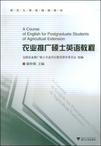农业推广硕士英语教程
出版时间:2008-11 出版社:浙江大学出版社 作者:郁仲莉 主编 页数:369
前言
呈现在读者面前的是由郁仲莉副教授主编的《农业推广硕士英语教程》。作为从事数十年农业院校英语教学并主编、主审过多本农业英语教材的老教育工作者,我欣慰地看到郁仲莉这一代教师在教育理念和教育实践上继承传统、勇于创新的不懈努力。本教材既全面反映了编写者丰富的研究生英语教学和科研经验,又准确体现了农业推广硕士这一特殊学位类型的英语学习的要求。 具体来看,这本教材有以下几个显著的特点:第一,学用有机结合。通过大量实用、新颖和前沿的农业推广领域的英文文献,为学生提供了一个其他方式难以取得或替代的英语学习环境,这里不再有“学用分离”,有助于培养学生学习英语,特别是用英语为专业服务的兴趣和信心。第二,结构编排包括主辅课文设计和课文练习设计合理而充分。每篇课文的辅助材料在专业点和语言点上都构成了对主课文的补充和扩展。每一课的练习不仅有课堂后的书面作业,更有适合于课堂上的分组集体讨论等题目,因此把教材创新和教学创新很好地结合了起来,对教学双方有效使用教材也有一定的引导作用。第三,每篇课文的注解不再拘泥于语言本身,关注的主要是从专业知识角度出发的难点和重点。这里重要的不是孤立的英语字词或语法的意义,而是英语作为交际手段所传达出的专业信息。学生不必将英语作为一门学问来学习(这是我国高校英语教学长期以来“费时低效”的一个重要原因),而是作为一个工具、一个媒介来使用,在使用中锻炼和提高英语水平。 这本教材是我国农科英语教材和专业学位英语教材编写工作中的一项新的尝试。毫无疑问,这项尝试的价值及其有效性的切实发挥还有赖于广大师生认真并创造性地使用该教材。是为序。
内容概要
《农业推广硕士英语教程》系全国农业推广硕士专业学位教育指导委员会组织编写并推荐的农业推广硕士研究生教材,由全国农业推广硕士专业学位教育指导委员会资助出版。本教材结构上包括12个单元,每个单元由A、B、C三篇内容相关的课文组成。课文A为主课文,课文B和C为辅助性课文,课文后是注解和练习,书后配有练习答案。内容上涉及四大主题:以农民为中心的农业推广(farmer-led extension),推广中的性别问题(gender and extension),果蔬、家禽和营销(growing vegetables and fruits.poultryand marketing),以及可持续农业(sustainable agriculture)。适用于农业推广硕士研究生、农科院校的研究生和教师,以及广大农业科技工作者。
作者简介
郁仲莉,江苏清江人。研究方向为翻译理论与实践,翻译批评,应用语言学与外语教学。主编出版研究生教材、词典4部(其中教育部、农业部规划教材各1部),译著1部,教学磁带3盘,教学、文化等研究论文6篇。获省部级奖励5项,校级奖励5项。
书籍目录
序前言Unit 1 Agricultural Extension in Developing Countries Text A Problems and Ideas in Agricultural Extension Text B Training Agricultural Extension Workers Text C Adoption and Diffusion of InnovationsUnit 2 Management Planning and Policy Text A Managing Agricultural Extension Text B Programme Planning Text C Group Promoters in Rural DevelopmentUnit 3 Farmer-led Extension Text A Concepts and Practices in Farmer-led Extension Text B Roles and Responsibilities in Farmer-to-farmer Extension (1) Text C Roles and Responsibilities in Farmer-to-farmer Extension (2)Unit 4 Issues and Problems in Farmer-to-farmer Extension Text A Selection of Farmer-extensionists Text B Payment and Time Allocation Text C Other Issues and ProblemsUnit 5 Understanding How Gender Affects Agricultural Production Text A Gender Factors and Women's Roles in Agriculture Text B Constraints Women Farmers Face: Barriers to Access (1) Text C Constraints Women Farmers Face: Barriers to Access (2)Unit 6 Improving the Delivery of Extension to Women Farmers Text A Gender in Agricultural Extension Text B Communicating with Farmers Text C Monitoring and EvaluationUnit 7 Pest Control in Growing Vegetables and Fruits Text A Natural Methods for the Prevention of Pests in Cultivated Plants Text B Natural Methods of Pest Control Text C PesticidesUnit 8 Poultry Text A Poultry in Con Text Text B Integration of Poultry Production into Agricultural Systems in the Tropics" Text C Marketing Poultry ProductsUnit 9 The Wheels of Trade Text A Developing Markets for Business Services Text B Setting the Terms of Discussion: A Model for the Delivery of BDS Text C A Fresh Analysis of a Traditional ApproachUnit 10 Farming for the Future Text A Sustainable Agriculture Text B Agricultural Research and Extension Text C Additional Options for LEIAUnit 11 LEISA in Perspective (1) Text A In Search of Sustainability Text B Processes That Cause Change and Affect Sustainability Text C Is Agricultural Intensification Ecologically Sustainable?Unit 12 LEISA in Perspective (2) Text A Different Expressions of LEISA Text B Participatory Learning, Planning and Action toward LEISA Text C Building Bridges to LEISAKey to ExercisesBibliography
章节摘录
The need to improve the content of extension, especially in connection with food crops, has promoted the setting up of international research centres such as the International Rice Research Institute (IRRI) in the Philippines and the International Maize and Wheat Improvement Centre in Mexico. Innovations in the production of both cash and food crops are essential if a profitable programme is to be assembled for subsistence farmers. The advances which have been achieved by IRRI and similar institutions are the result ofc ooperation between extension and research staff. Innovations can only be adapted to the needs of local farmers by coordinated effort. Appropriate technology can be evolved only on the fields of farmers. Coordinating extension with other services The principal lesson to be learned from agricultural extension over the last 50 years is tha textension programmes succeed only when linked to research, the or ganised delivery of farm in put sand outputs, and credit and attractive prices for farmers. National extension services have contributed little in isolation because technical information without other facilities cannot assist the farmers. While it is true that extension workers should not get personally involved with organising credit, distributing supplies and marketing, they should be familiar with the activities of credit agencies and farm suppliers and be able to coordinate their work with them. In Latin American countries, officers of credit agencies are a major source of extension assistance. Recognition of the interlocking nature of agricultural-production systems lies behind such approaches to rural development as package programmes, contract farming, integrated development and community development. These approaches involve coordinated action by the development agency in a number of interrelated areas. Integrated development emphasises the importance of improved social services as well as the technical improvements of agriculture within a region. Underlying community development is the recognition that if people are to change their attitudes to agricultural progress, they must first have a good reason. Learning new agricultural practices is a means to an end and not an end in itself. Progress must begin with changes in the attitudes of people themselves. In all approaches to rural development, the role of the extension worker is basically the same: to demonstrate acceptable improvements and seek ways of bringing their adoption within the grasp of farmers. This work has long been central to rural development because extra production must always come first in order to: 1. increase farmers incomes 2. increase off-farm employment by spreading the extra income in various employmentgiving ways 3. increase government revenue and help pay for other services such as clinics, schools andwater supplies. Most rural development too easily slips into these other services because it is much easier and more popular to build schools and clinics, etc. than to increase output. The result is that there is no radical cure of poverty which springs from low productivity.
图书封面
评论、评分、阅读与下载
